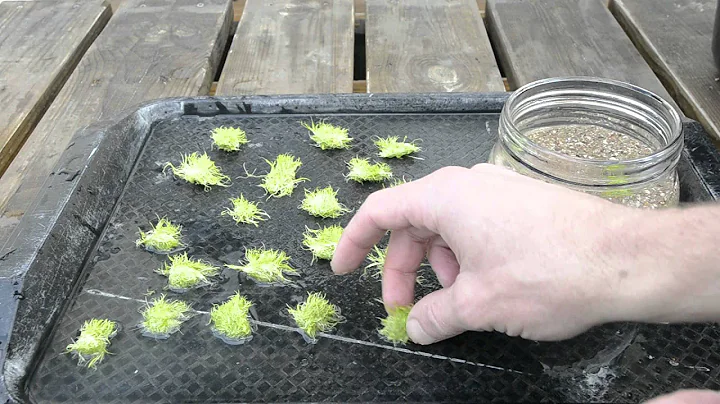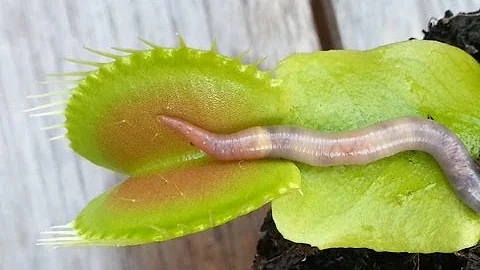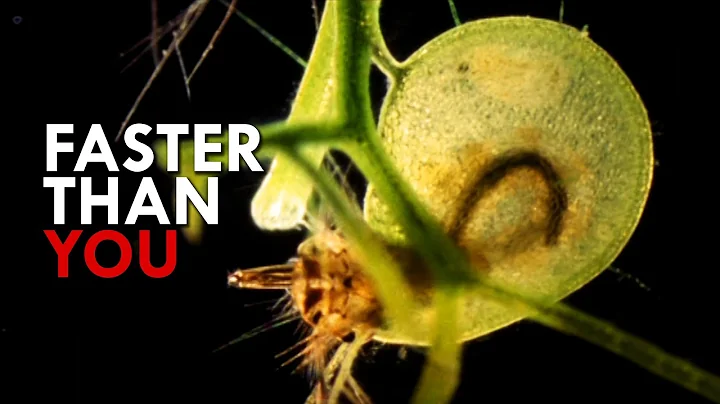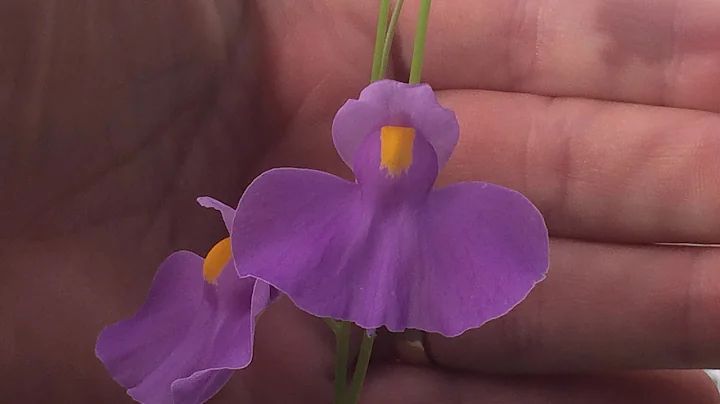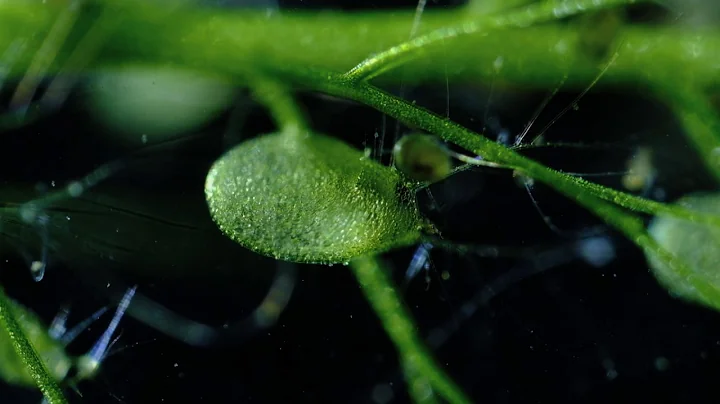This chapter talks about Utricularia foliaceus alone. This section is a section worth collecting. Most varieties have larger leaves or more distinctive leaves, and the size and color of the flowers are also unique.
Foliosa: This group was previously called the parietal Utricularia group. From a non-professional perspective, the leaves of the Utricularia species in this group are relatively large, and most of them are elongated. Linear and elliptical leaves. Peter Taylor previously divided this group into two parts. In addition to the Utricularia foliaceus group, it also divided the Utricularia group (Psyllosperma), such as Utricularia elongata, Utricularia bilobata and Utricularia longifolia. Utricularia and others were previously classified into the Utricularia polygonum group. The previous phylloid Utricularia group only had three species: Amethyst Utricularia, Utricularia tricolor, and Utricularia tridentata. However, research in 2006 showed that the two groups could not be divided into independent units, so the two groups were later merged together.
U. amethystina: In 2002, a study based on ISSR technology analyzed the interspecific relationships of 10 terrestrial species of the genus Utricularia . A total of 6 primers were used for ISSR expansion, resulting in a total of 236 fragments. Amethyst Utricularia was determined to have the closest interspecific relationship with U. calycifida. The morphological characteristics are also consistent with this conclusion. Both have unequal sepals, globular insect cysts and oblique-ovate seeds.
Family relationship map based on molecular biology:

Amethyst Utricularia grows mostly terrestrial in the wild in open and low-lying moist sandy or peat soils. The type origin is two villages in northeastern Florida (Lee, Collier), so it used to be called Florida Utricularia. However, no one has seen it for many years. The circle agrees that it is completely extinct in the wild in the United States. It is interesting. This species of Utricularia was the first species of Utricularia to become extinct in the United States. Of course, there are still populations in Latin America in Bolivia, Brazil, Guyana, and Peru, but populations in these places have been recorded. The altitude distribution is higher, between 1200 meters and 1850 meters. In the wild, the growth years of each population are different. Most are annuals, but there are also perennials. Relatively speaking, perennial plants are smaller.
Amethyst civet The flowers of algae have various colors, the most common color is purple, others include light blue, white, cyan, pink, cream and bright yellow, and the size and shape of the flowers are also variable. The lower lip of the petals has continuous petals , three-lobed petals, "wavy edge" petals and other forms of expression. Even if they are of the same color, the flower colors are of different shades, and even have transitional colors, and the flower shapes are large or small. The flowering period in the wild is generally at its peak in May. At present, It is said that the Florida population is generally purple, with tall flower stems, 30-50 cm high.
Lilac individuals with variable flower shapes:

The purple-colored Amethyst Utricularia may be more consistent with the scientific name. Of course, it is also among the individuals of all colors. The color system that produces large flower individuals:


Close-up of artificially cultivated amethyst Utricularia flowers:


Pink flower individuals:

Other pink individuals with variable flower shapes and slightly different flower color shades:

The bottom of the transition from light pink to white Tricleft labial type:

Multi-flowered individuals with white to cream color transition:

And in 1994, Fernando Rivadavia (Femanda Rivadavia) discovered Amethyst Utricularia in Matogue during an investigation in Brazil. There are two varieties in Chapada dos Guimarães on the Roseau Plateau. One is a white-flowered variety with extremely small flowers. They often bear single flowers on the inflorescence axis. They are mostly perennial, but are also common in eastern Brazil. It can be seen that it grows as an annual in sandy soil.
White individual:

White wide-petaled individual:

Close-up of the white individual from Auyan Tepui:


Another variant is the yellow-flowered variant, with multiple flowers on a single inflorescence axis and long pedicels. It only exists on the Jimaliangsi platform and is an annual. The leaves are arranged in a rosette shape and the upper surface is usually covered with mucilage, but these two characteristics disappear after artificial cultivation. In addition, even if the substrate is kept moist during planting, all the leaves will wilt at the end of the dry season.

Wide-petal yellow variant:

For other terrestrial Utricularia algae, it can tolerate more shade. In the wild, the growing environment is also more variable, from the shade of tall herbaceous plants to semi-aqueous swamps. They are distributed on the mountain walls.
Typical wild environment for the growth of Utricularia amethyst:

Amethyst Utricularia blooming in the wild:

Plant shape of Utricularia amethyst:

Close-up of leaves:

Utricularia bilobata (U.calycifida): written separately above That’s it, no more to say here.
U.praelonga: A medium to large perennial terrestrial carnivorous plant, U.praelonga is endemic to South America and is found in northern Argentina, southern Brazil and Paraguay . Utricularia elongata was determined to have the closest interspecific relationship with U. uliginosa. In terms of morphological characteristics, this conclusion is also consistent. Both of them have oval bracts, diamond-shaped or narrow linear short bracts. The species epithet "praelonga" comes from the Latin "praelongus", which means "extremely long, extremely tall" and refers to its leaves with an extended growth period. Utricularia elongata has a rare phenomenon in terrestrial Utricularia. Its leaves have two shapes as the temperature changes, that is, slender leaves in high temperature periods and wide and round leaves in low temperature periods.
The bright yellow flowers are not unique in the entire genus Utricularia, but the overall characteristics of all Utricularia elongata plus the yellow flowers are quite distinctive:


Comparison of the flower size of Utricularia longifolia and Utricularia longifolia :

It is difficult for Utricularia elongata to bloom here. I don’t know the reason. After cultivating it, I found that neither low temperature to promote flowering nor reducing the photoperiod can make it bloom. Personally, I don’t really like Utricularia japonica very much, but because it has never been able to bloom successfully, it belongs to the kind that has never been able to bloom successfully, so I have been keeping it in my hands for experiments.
The artistically grown Utricularia protuberans that have bloomed in other people’s greenhouses:


Artificially planted Utricularia protuberans:

Close-up of the leaves of Utricularia protuberans:

This kind of splitting of the leaf tips is common to all Utricularia protuberans in me. Currently, only Utricularia longifolia is the most common on the body, but I haven’t seen it on Utricularia protuberans here:

Furthermore, when I looked at pictures of Utricularia protuberans, I found that the growth period of Utricularia protuberans raised in the wild and by others was The leaves are very tall and have upright leaves as wide as noodles, but mine are not, which is very strange (of course I also raised them later, and then read on):


In the actual breeding for so many years, I found that the extension of the civet Algae are very tolerant to the sun. I have been exposed to full sun all year round and have not died from the sun. They are also very tolerant to grass. They have not died of heat or freezing in my area. It is easy and stress-free at temperatures between 5 and 35 degrees Celsius. At first, peat was used to grow the plant on the balcony. The root system grew directly into the water and turned into a dense white net-like root. When planted on the balcony, the slender leaves of Utricularia japonica were particularly soft and slender during the high temperature period. , it is no exaggeration to say that the thinnest part can be as thin as a hair, like a mess of hair spread on the substrate, and the leaves are covered with purple sun spots. The higher the temperature, the stronger the sunshine, the thinner the leaves, and the more purple sun spots.
At that time, Utricularia elongata without too many sunburns was planted on the balcony in autumn:



Later, I found that after two years of cultivation, it did not bloom, so I used sphagnum moss and hung it in the freezer. I wanted to try the low-temperature flowering method. , of course it didn’t bloom. Then I thought about it, maybe the temperature difference and temperature cycle were enough, but the photoperiod of the freezer is constant, so there may not be a simulated short daylight situation to promote the differentiation of flower buds and flower stems. It’s just a personal guess and I don’t have time to do experiments. . After putting it in the freezer, I found that the slender leaves during the growth period had turned into upright leaves, and the upright leaves were much thicker than those on the balcony. I also discovered the reason. In fact, this kind of dried noodles will appear in medium-temperature, strong light and extremely high air humidity. I call the same leaves "noodle leaves", but the higher the temperature, the leaves will become thinner, and if the temperature is too low, they will become oval leaves. As long as the temperature can be controlled, strong light will only make the leaves appear yellow, but if the light is too strong, purple sun spots will still appear.
The Utricularia protractosa grown in the freezer with sphagnum moss on the wall finally grew the "noodle leaves" in the information picture:


The flowering picture of Utricularia protractosa in the wild:

I will also show you the environment of the native place, not just for you. You see the horses eating grass on the prairie, haha, this is the real environment of Utricularia prolifera mixed in the grass on the prairie: (Of course, it is more commonly distributed in swamps, peat grasslands and along rivers)

Utricularia striata ( U.hispida): A medium-sized perennial terrestrial species, endemic to Central and South America. The species epithet "hirta" comes from the Latin "hispidus", meaning "hairy, rough", referring to its hairy plant. After cultivating it personally, I found that the leaf shape of Utricularia is very similar to that of elongated Utricularia. It also pulls out elongated leaves during the high-temperature growth period, and turns into oval leaves during the dormant period. It is very interesting. I don’t know if there are other Utricularia algae that also have double-leaf type conversion. this phenomenon. However, Utricularia striata is afraid of the cold. After all, the altitude is only 500 meters, while Utricularia elongata can reach up to 1,500 meters, which is three times the altitude. My current plants on the balcony will almost die in winter, but after reducing watering, the underground stems are still very capable of resurrecting, and then "spring breeze blows". However, actual cultivation found that the growth conditions in summer are also very average, and it prefers a mild climate. The flower colors of Utricularia striata are extremely variable, ranging from blue, purple, and pink to yellow, cream, white, and light brown. Generally speaking, pink-flowered individuals are found in the island hills of southern Guyana, and yellow-flowered individuals are more common in the white sandy soil along the coast, but the inflorescences along the coast are smaller and completely green. Although the flower stems of Utricularia are super tall! ! ! Still very hard! However, the flower stems in the forest will be softer and tender, while the Utricularia flower stems growing in the open areas next to the road will be more "woody". I browsed the website two years ago and found that most of the products sold online are cream and light yellow.
Blue:

Lilac:

Cream:

White:

Light brown to light yellow:


Other flower colors:

The flower stems of Utricularia striata are very high, and the flower stems of Utricularia striata in the wild are:
 8
8
thick during growth period "Noodle leaves", which can grow up to 60 centimeters:

Artificially cultivated Utricularia:

Utricularia can survive in any wetland and other muddy areas with vegetation, such as along roads in forests, red soil grasslands, on beaches, It can be found along wet roadsides, between fences and roads.
Widely distributed living environment in the wild:


U. huntii: In 1986, Peter Taylor formally described U. huntii. A medium-sized terrestrial perennial species, the species epithet "huntii" comes from the American plant collector David Richard Hunt. It is endemic to Brazil and has only been found in 5 distribution locations. It is mostly distributed in the wild on the edges of moist grasslands and swamps, and is also common on the banks of puddles with accumulated water. Although its habit is recorded as terrestrial, it is also grown as an epiphyte in cultivation. However, cultivation is rarely seen.The overall plant of this species is very interesting, and the leaf arrangement is very similar to Utricularia spiralis.



Hunter's Utricularia that grows mixed with Drosera in the wild:

U.longifolia: A perennial large Utricularia, endemic to Brazil. The species epithet "longifolia" comes from the Latin "longe" and "folium", meaning "long" and "leaf", referring to its long leaves. The interspecific relationship between Utricularia longifolia and U. alpina is the closest. In terms of morphological characteristics, both have elliptical or obovate leaves, curved filaments, oval ovaries, and sepals. Oval to ovate-triangular. However, Peter Taylor placed these two species in the Orchidioides and Foliosa groups in his 1989 monograph "Utricularia - A Taxonomic Monograph". Judging from the shape of the leaves and the characteristics of the large blue-purple flowers, I am still accustomed to treating it as an orchid Utricularia. And although it is recorded as a terrestrial and rock plant, it is particularly effective as an epiphytic species. However, due to the flowering habit of Utricularia longifolia, it requires a period of lower low temperature to catalyze the differentiation of flower buds compared to the Orchid Utricularia group. In addition, the habit of semi-aquatic to terrestrial is not a problem for Utricularia longifolia. In addition, it itself was The recorded habits are described as terrestrial or rock-dwelling, so most people still support staying in the Utricularia foliaceus group. The leaves of Utricularia longifolia can be more than 30 centimeters long and are elongated. In my environment, bilobed tips often appear at the end of the leaves.
Illustration of Utricularia longifolia published in 1913:

The flowers of Utricularia longifolia are really big and purple, and they are that kind of deep purple. However, the color will not be deep enough due to high temperature. First, enjoy the flowering picture of Utricularia longifolia:




Two high-definition close-up pictures:


Utricularia longifolia, which is grown together with highland plants, can be said to be very suitable for highland tank landscaping species because it has good tolerance to high temperatures and is more resistant to humidity. However, flowering requires low temperature stimulation:

Comparing it with the flowering picture of Utricularia japonica in the Orchid Utricularia group, you can see that the darker color actually looks more showy (the dark purple on the left is Utricularia longifolia, the light purple on the right is Utricularia nitricola):

I threw it in Picture of Utricularia longifolia blooming in the wild on the balcony. The flower stems can reach more than 60 centimeters. Because I was not at home, my family took a few pictures for a quick look:

The leaves can really reach 30 centimeters easily:

This often happens during high temperature periods This phenomenon of two-lobed leaf tips:

and the leaves infected by red spider mites that I pulled out (you can use medicine or remove them manually, but I am lazy, I like rough methods):

Utricularia longifolia is very tolerant to sunlight but not tolerant either. Sun, sunbathe as much as you like during the low temperature period, purple spots will appear:


The stem roots and dense insect sacs that are entangled with each other on the pot wall, it is time to change the pot:

Growing on the balcony Although it can naturally promote flowering in winter, there is no need Electric natural light, but attracts spider mites, and spider mites like to "gnaw" Utricularia longifolia and Utricularia bilobata in my area. The leaves are large and juicy! In addition, I was away from home all year round and couldn't take care of it. Later, I changed the substrate from peat to sphagnum moss and stuffed it in the freezer while repotting. Because it was full of water when left on the balcony, the sphagnum moss was easy to rot. The peat used in the lower part Perlite is the transition, and if you throw it in the freezer, it will really be grown in an epiphytic way. Pure sphagnum moss is the best. In addition, Utricularia longifolia does not need a very low temperature for vernalization to bloom as stated in the book. This winter, whether on my balcony or in the freezer, the night temperature is ten to fifteen degrees, and it blooms again every year. But it is indeed not like some species of the Orchid Utricularia group that can bloom continuously as long as they maintain a suitable temperature range. Instead, they need a period of low temperature to catalyze the differentiation of flower buds, a bit like Dendrobium.
In an environment with strong light and low temperature, the leaves of Utricularia longifolia become small and stiff, the flower stems are also greatly shortened (either long or short), and the sphagnum moss becomes denser and tighter:



Utricularia longifolia generally grows in the wild. Utricularia longifolia grows along rivers and in wetland grasslands, but the size of Utricularia longifolia in the two habitats is completely different. The relative density of U. longifolia growing along rivers is larger, but the length of the leaves is pitifully smaller:



The leaf length of Utricularia longifolia growing in the native environment of wetland grasslands is extremely exaggerated. Feel it for yourself:

Data shows that in addition to the original Utricularia longifolia, there are currently two mainstream cultivated varieties, both of which are mutated towards smaller leaves and flower colors. Also slightly different. In addition, some gardening companies may have unregistered individuals that are named according to their different expressions or combined with geographical distribution and sold through online channels. This is actually a matter of judgment. There is never too many collectors. And perfectionists only want the best individuals, right~
One is the lavender short-leaf variant U.longifolia var. forgetiana. The most striking feature of this variant is that the leaves are shorter, only about 6-10 cm long, and the flower color is also the same. Purple, but after most cultivation, the color is relatively paler, mainly lavender. Especially when the temperature is high during the day, the overall color of the flowers will be white, but most of them have a little bit of purple. In addition, the flowers are relatively smaller and the flower stems are shorter, usually about 40 cm, but there is no obvious difference in cultivation:






The other is U. longifolia f. bonsai with individual pink flowers: This is It is a very cute variant of Utricularia longifolia, which looks like it has dwarfism. The flower color is generally light pink to pink. The flower color of this variant is relatively easy to distinguish:




Individual pink flowers with more obvious color difference:


Panamanian bladderwort (U. panamensis): Its species epithet "panamensis" comes from its discovery Panama is endemic to Panama and is only distributed in the type origin and several locations in the same area. In 1977, Peter Taylor first described it as "Utricularia sp.", and in 1986, the description of Utricularia panama was officially published. The leaves resemble immature Utricularia longifolia, or Utricularia elongata in the leaf transition period. The flowers also have many similarities to Utricularia longifolia.
Structural diagram:

Panamanian Utricularia clustered in the wild:


Flowering picture:

Hinton Utricularia (U.hintonii): a small annual rock species, endemic to Mexico , and its type origin only exists southwest of Mexico City About 160 kilometers west. The species epithet "hintonii" comes from the American plant collector G. B. Hinton, and it was officially described by Peter Taylor on June 10, 1933. The flowers of this species are very small, and there are not many records:

Peterson Utricularia (U.petersoniae): a small annual rock species, endemic to Guerrero State, Mexico. The species epithet "petersoniae" comes from K. M. Peterson, an American plant collector who was one of the discoverers of Utricularia Peterson. Petersen's Utricularia was first described by Peter Taylor in 1986. The wild altitude is distributed among the moss on the rock walls between 2900 and 3200 meters, and these moss-covered stones usually have waterfalls or flowing water flowing through them.



Native environment in the wild:



The small, round leaves are also quite distinctive:


Utricularia regia (U.regia): It is an annual rock-growing carnivorous plant, endemic to Mexico, and is limited to southern Guerrero state in Mexico. Sierra Madre . The species epithet "regia" comes from the Latin "regalis", meaning "king".Utricularia kingis grows in moss between rocks or among selaginella in pine forests, with an altitude distribution ranging from 1650 meters to 1900 meters. The flowering period is from September to October, and the fruiting period is from October to November. Utricularia kingis is similar to U. hintonii and U. petersoniae, but Utricularia kingis has a special 4-lobed upper lip of the corolla and a unique color. The petals of this species are divided into two parts. It is divided into two parts from a linear shape to a spoon shape, and then divided into two parts into a bamboo sheet shape, and is divided into four pieces in total. It was discovered in 2005, and was collected again during subsequent botanical expeditions for Flora de Guerrero. Utricularia regal was formally described in 2009 by Sergio Zamudio and Martha Olvera in Brittonia 2009, who were the first to assign it to Peter's order ·The Psyllosperma group established by Taylor was later classified under the Foliosa group based on molecular phylogenetic analysis.

Blurred petals close-up:

Schultesii (U.schultesii): a small perennial terrestrial species, endemic to South America, only found in Colombia and Venezuela. The species epithet "schultesii" comes from the plant collector Schultes. Alvaro Fernández-Pérez first published a description of Utricularia schultes in 1964.

Close-up of flowers:


Flowering picture of artificially cultivated Utricularia Schultes:

U.tricolor: a medium-to-large perennial terrestrial species, which is diploid and has a chromosome number of 2n=28. Endemic to South America, found in Argentina, Brazil, Bolivia, Colombia, Paraguay, Uruguay and Venezuela. The species epithet "tricolor" comes from the Latin "tri-" and "color", which means "three" and "color", referring to the three colors of its flowers: purple, yellow and white, but in fact this color combination is not limited to Utricularia tricolor Yes, for example, Utricularia longifolia in the same group also has the same color scheme, except that the middle part of Utricularia tricolor is whiter. Of course, this is only relative. The yellow part of Utricularia tricolor also accounts for a relatively large proportion. The flowers of Utricularia tricolor are much larger than those of Utricularia tricolor. However, Utricularia tricolor and Utricularia tridentata are easier to mix on the leaves and are easier to distinguish under artificial planting. However, they are very similar in the wild and their distribution areas overlap with each other. The leaves of Utricularia tricolor are relatively resistant to sunlight, and the plant has beautiful fan-shaped or kidney-shaped leaves. It is easier to draw flower stems, but the flowers are more likely to abort.

Comparison picture of hands:

The kidney-shaped leaves are very cute:

Close-up of artificially planted plants:



The flower stems are also relatively thick:

Field environment reference picture of Utricularia tricolor:
 8
8
Close-up of Utricularia tricolor in the wild:




Tridentata (U.tridentata): a small terrestrial species, its species epithet "tridentata" comes from the Latin "tri-" and "dentatus", meaning "three" and "dentate", referring to its three Tooth-shaped flowers. It is endemic to South America and is found in Argentina, Brazil and Uruguay. The leaves are similar to Utricularia tricolor, very cute, with lavender or light pink flowers, sometimes the whole body is white. A beautiful, easy-to-grow variety, but too hardy to thrive under the right conditions in a greenhouse, often spreading everywhere.



Relatively rare "double-headed flower":

Cute nearly round leaves:

Leaf close-up:



Developed stems and roots are easy to spread and grow:

In the wild Status:

Finally, the habits of the Utricularia foliaceus group are attached. And distribution summary:
Utricularia foliaceus group:

-- The end --

